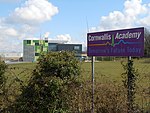Loose, Kent
Loose is a village some 2 miles (3 km) south of Maidstone, Kent, situated at the head of the Loose Valley, with which it forms the Loose Valley Conservation Area. The fast- flowing River Loose which rises near Langley runs through the centre of the village and once supported a paper-making industry, evidence of which can still be found. An area round the village is also known as Loose, but Loose village itself is based in the Loose valley and extends along Busbridge Road towards Tovil. The name is believed to be taken from the Loose Stream, which "loses" itself for several miles underground from the point where it rises in Langley (Edward Hasted: Hlosan in Saxon, signifying to lose or be lost).
Excerpt from the Wikipedia article Loose, Kent (License: CC BY-SA 3.0, Authors).Loose, Kent
Church Street,
Geographical coordinates (GPS) Address Nearby Places Show on map
Geographical coordinates (GPS)
| Latitude | Longitude |
|---|---|
| N 51.2408 ° | E 0.5164 ° |
Address
Church Street
ME15 0BX , Loose
England, United Kingdom
Open on Google Maps






